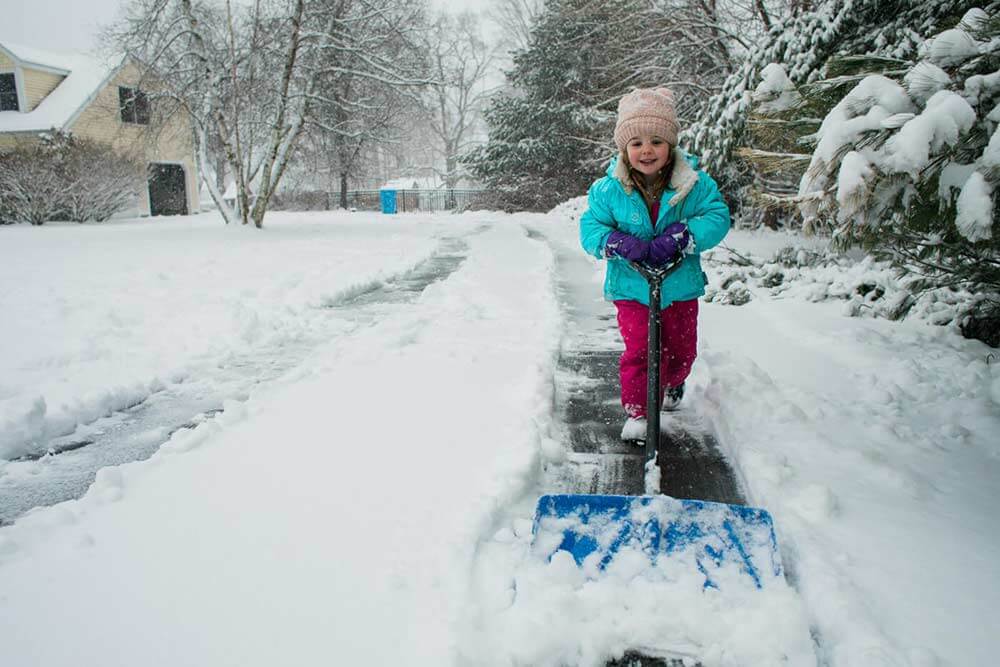
With our unpredictable Canadian winters, getting into a proper routine with snow removal can be tricky. Some days it’s heavy snowfall, followed by mild weather or freezing rain… or even more heavy snowfall.
When is the right time to shovel? What does this mean in terms of safety and liability for your property? We’ll explain why proper snow removal matters and share some tips to make it easier.
Snow removal tips and tricks
- You’d be surprised how much having a snow-removal plan specific to your property will help. Map out where it’s best to dump excess snow (for larger properties especially) while being mindful of your surroundings. Think about garbage and recycling pick-up, or if you have to park multiple cars in the driveway. Keep your neighbours happy by not pushing your snow across the road onto their property.
- Don’t miss the snow on your roof! Wet snow weighs about six times as much as dry snow and there’s a risk of structural damage if snow piles up too high. The best way to deal with excess snow on your roof is with a roof rake or a shovel. Position yourself a safe distance from where the snow will land – keep in mind where cars are parked and walkways. To avoid damaging your shingles, aim to leave 10-15 centimetres of snow on the roof.
Read more about how much snow your roof can hold. - To avoid making your job harder, it’s best to deal with snow as soon as possible. If you leave it for too long, it could melt and re-freeze as a layer of ice, turning your driveway into a skating rink.
Tip: Bend at the knees, lift with your legs, and try to avoid twisting too much.
- We can’t have you sitting out of winter activities with a sore back so always ensure you are properly lifting and shoveling snow. Bend at the knees, lift with your legs, and try to avoid twisting too much (your feet should be facing the direction you throw the snow in). Not only can wet snow be heavy, but constantly lifting and twisting your back can take a toll on your body – so take care of you first.
- Bonus tip: If you find the snow is heavy and sticky (as in, it’s not sliding off of the shovel) try using something like vegetable oil or WD40 to coat the shovel. This should save you from shaking excess snow off in between shovels and save you some time.
- Once you’ve cleared your driveway and any walkways, salting your property will help with melting any built-up ice underneath the snow. Apply a thin, even layer to icy areas, and always wear gloves!
Snow removal equipment and tools
Salt
Before you start throwing down any salt or sand, make sure you’ve cleared most of the snow away with a shovel first before using about a handful of salt per square meter. Remember, salt should only be used on icy areas and isn't needed everywhere.
There are different types of salt that work better for different situations. Excess salt is bad for the environment and can burn the roots of plants. If you have a pet or want to protect your gardens, there are safer, milder options to melt ice. Depending on how cold it gets in your area, there are also “heavy duty” options. If you’re using salt for traction only, consider using sand or kitty litter as a safer option.
Ergonomic shovels
If shoveling sometimes causes discomfort, look for ergonomic shovels. They are specifically designed to help keep your body in alignment and reduce pressure on your joints by evenly distributing the weight of the snow.
Snowblower
Are they worth the investment? Again, this depends on your property and how much snow the area you live in receives. We’d recommend an electric snowblower if you have a smaller property and easy access to an outdoor electrical plug. They’re perfect for clearing up to 30cm of snow and easily fit onto areas like decks or walkways. Otherwise, a gas snowblower is best if you have a larger property and receive more than 30-35cm of snow.
Snow removal service
If you have a longer driveway, or just want the job done faster, consider hiring a snow removal service. Some municipalities offer snow removal for seniors, physically disabled and for those who require financial assistance. If you’ll be away from your home for any period of time (hello vacation!), this also might be the best way to maintain your property in your absence.
Snow removal and liability